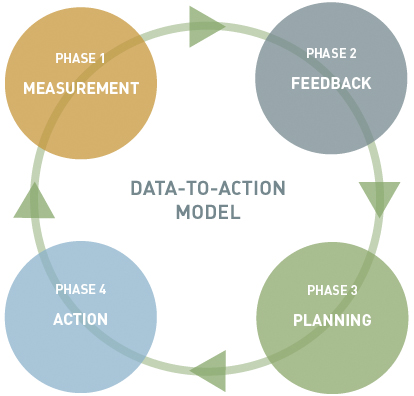We achieve the strongest, most comprehensive outcomes for our clients when we are able to combine several of our service offerings into a suite of services within the context of a longer-term relationship. This allows us to repeatedly apply the Data-to-Action model to our focus on assessment and development at the individual, team, and organization level across time, with each cycle starting at ever-increasing levels of performance and competence.

Once a client need has been identified or a problem diagnosed, we move into our Data-to-Action model, which is characterized by a repetitive cycle that moves through four phases to achieve continuous development and improvement.
Phase 1: Measurement…the scientific methodology.
The initial phase in the Data-to-Action model is the measurement stage in which information is gathered that will inform the subsequent action. Each of our consultants holds an advanced degree in psychology. Coming from a scientist – practitioner model, we are dedicated to the discipline of research in the applied arena: thoroughly gathering all relevant data and bringing it to bear on the issue at hand. The measurement methods we use to gather data vary according to the specific situation and the level at which the work is being done, and can include psychological assessment, personality instruments and cognitive measures, individual interviews, focus groups, process observation, surveys, and performance data.
Phase 2: Feedback…a joint discovery process.
One of the defining hallmarks of our Data-to-Action model is the collaborative nature that must exist between the consultant and the client (i.e., the individual, team, or organization under study). The diagnostic data, gathered in Phase 1, are fed back to the client by the consultant, who then helps the client determine strengths and weaknesses of the client. The feedback is given in the spirit of being part of a joint discovery process where we partner with the client to develop a rich understanding of the client’s current state of affairs.
Phase 3: Planning…our clients know their business best.
Once we provide the client with all relevant and useful data, we work with the client to analyze the data, looking for the most compelling patterns and trends, and determine ways to optimize the strengths and minimize the weaknesses. The collaborative nature of this joint diagnostic and planning process is a key ingredient in distinguishing our Data-to-Action model from the “doctor-patient” model in which a physician comes in and independently makes a diagnosis of the patient and prescribes a solution. We know our clients know their business better than anyone. The collaborative process, and the resulting relationship that develops between the consultant and the client, provides the context and shared frame of reference necessary to create buy-in and commitment on the part of the client for the action phase. At the end of the planning phase, the consultant and client have agreed on what actions need to be taken, and have put appropriate goals in place.
Phase 4: Action…it’s the results that count
The action stage is where the hard work of implementing the plans developed in the previous stage takes place. This is the period of time when the client, with our assistance, takes steps to transition from the current state to the desired future state that has been conceptualized in the planning process. This is the step where we should see shifts in the behavior of the individual, team, or organization that will take the client to a higher level of performance.
Then, back to square one…
The cyclical nature of the Data-to-Action model instructs us to move from Phase 4 back to Phase 1 where, through the measurement process, we can gather information after the action has been taken to assess the impact of the action and improvement in performance. This is naturally followed by another feedback process which flows into further diagnosis and planning, and to the revision and/or resetting of goals along with the resulting new action and ever increasing levels of development and performance.
